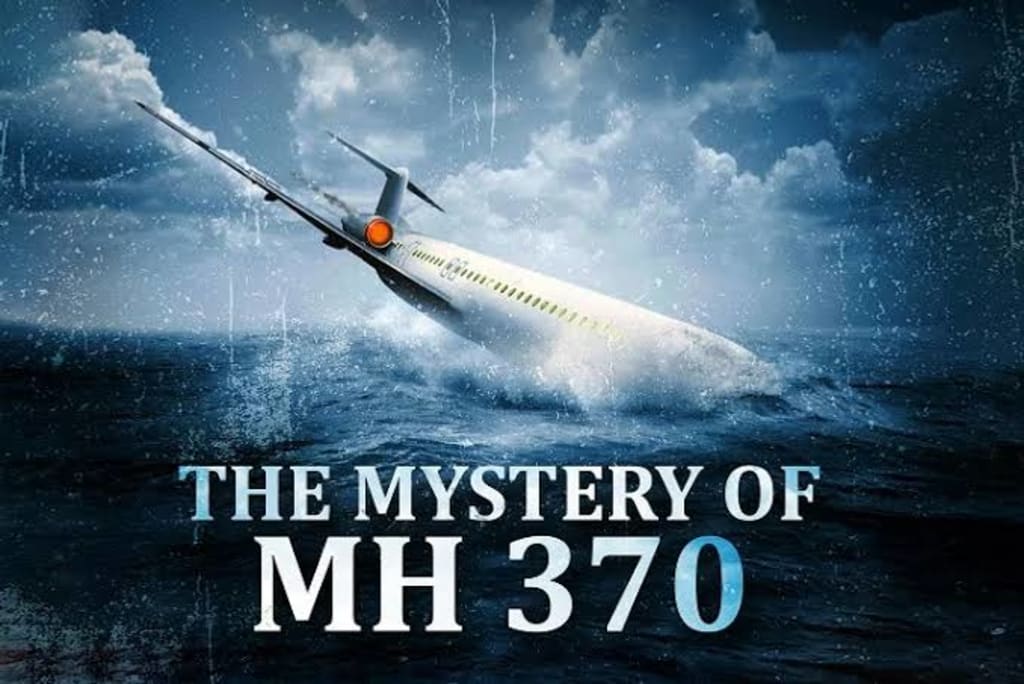Unsolved Mysteries
The Enigmatic Disappearance of Flight MH370

Introduction
In the realm of aviation history, few mysteries have captured the world's attention and imagination as profoundly as the disappearance of Malaysia Airlines Flight MH370. On March 8, 2014, this Boeing 777-200ER vanished while en route from Kuala Lumpur International Airport to Beijing Capital International Airport, leaving 239 passengers and crew members aboard. Despite extensive search efforts and investigations spanning years, the plane's ultimate fate remains unknown, shrouded in a web of unanswered questions and conspiracies. Join us on a journey to explore the baffling circumstances surrounding the disappearance of Flight MH370, a puzzle that continues to baffle experts and the public alike.
The Vanishing Act
On that fateful evening in March, Flight MH370 took off from Kuala Lumpur with the typical routine checks and procedures. The flight crew was experienced, and the plane itself was well-maintained. Nothing seemed out of the ordinary as it climbed to its cruising altitude, maintaining steady communication with air traffic controllers.
However, approximately 40 minutes into the flight, the aircraft's transponder and communication systems suddenly went silent. The plane's position and altitude information ceased to be transmitted, leaving air traffic controllers puzzled. MH370 had seemingly vanished from radar screens without any distress calls or indications of trouble. This abrupt disappearance marked the beginning of a mystery that would baffle aviation experts, investigators, and the global community for years to come.
The Search Efforts
In the immediate aftermath of the disappearance, a massive international search and rescue operation was launched. The initial focus was on the South China Sea, where the plane's last known radar contact occurred. However, as the investigation progressed and new data emerged, it became apparent that the flight had veered off its planned route.
The search efforts expanded to encompass a vast area spanning the southern Indian Ocean, covering millions of square kilometers. Multiple countries, including Malaysia, Australia, China, and the United States, joined forces to scour this remote and treacherous expanse. The search was characterized by its unprecedented scale and complexity, involving advanced technology, satellite imagery, and underwater exploration.
Despite these extensive efforts, the wreckage of Flight MH370 remained elusive. In March 2015, a piece of the plane's wing, known as a flaperon, washed ashore on the island of Réunion in the Indian Ocean. While this discovery confirmed that the plane had indeed crashed into the ocean, it provided few clues about the exact location of the crash site or the events that led to the disappearance.
Theories and Speculations
The lack of concrete evidence and the enigmatic circumstances surrounding MH370's disappearance led to a multitude of theories and speculations. Some of these theories were grounded in evidence and expert analysis, while others ventured into the realm of conspiracy and conjecture. Here are some of the most prominent theories that emerged:
Mechanical Failure: One of the initial theories suggested that a catastrophic mechanical failure, such as a fire or structural damage, incapacitated the crew and led to the plane's descent into the ocean. However, this theory could not explain the deliberate diversion of the aircraft from its planned route.
Pilot Suicide: Another theory centered on the possibility of deliberate human intervention, specifically pilot suicide. Some speculated that one of the pilots intentionally crashed the plane. However, investigations into the backgrounds of the flight crew did not uncover any significant red flags or motives.
Hijacking: The possibility of hijacking was considered early in the investigation, but no group or individual claimed responsibility, and no ransom demands were made. Furthermore, the lack of a distress call and the plane's diversion from its original route raised questions about this theory.
In-Flight Fire: Some experts theorized that an in-flight fire, possibly caused by hazardous cargo, could have incapacitated the crew and led to the plane's diversion and ultimate crash. However, no definitive evidence supporting this theory was found.
Controlled Ditching: A controversial theory suggested that the pilot executed a controlled ditching of the aircraft in a remote area of the Indian Ocean, intending to vanish without a trace. However, the lack of communication and the uncertainty surrounding the plane's final location cast doubt on this theory.
Cyberattack: In the age of digital technology, some speculated that the plane's systems could have been compromised by a cyberattack, leading to the loss of control and communication. While this theory raised concerns about aviation security, no concrete evidence supported it.
The Inmarsat Satellite Data
One of the most significant breakthroughs in the MH370 investigation came from Inmarsat, a British satellite telecommunications company. Inmarsat's satellite data analysis played a crucial role in narrowing down the search area for the missing plane.
Inmarsat analyzed the satellite communications data transmitted from Flight MH370 during its final hours. By examining the Doppler effect in the frequency of these signals, the company's experts were able to determine that the aircraft had followed a southern trajectory along one of two possible arcs: a northern corridor stretching from Kazakhstan to northern Thailand or a southern corridor extending deep into the southern Indian Ocean.
This groundbreaking analysis shifted the focus of the search efforts to the southern corridor, which was thousands of miles from the plane's last known position. It was a daunting task, as the vastness of the Indian Ocean and the deep waters below presented formidable challenges to search teams.
The Underwater Search
The underwater search for MH370 was an unprecedented endeavor that involved cutting-edge technology and collaboration among multiple countries. The search area in the southern Indian Ocean was known for its rugged seafloor terrain and extreme depths, making the search operation one of the most challenging in aviation history.
Two vessels, the Fugro Equator and the Fugro Discovery, equipped with advanced sonar and remotely operated vehicles, scoured the ocean floor for any sign of the wreckage. The search area was divided into priority zones based on the satellite data analysis, and painstaking efforts were made to systematically cover each area.
Despite the immense efforts and resources dedicated to the underwater search, no wreckage or definitive clues were discovered. The underwater search, which spanned years, was ultimately called off in early 2017, leaving many questions unanswered.
The Enduring Mystery
As of the date of this writing, the mystery of Malaysia Airlines Flight MH370 endures, and the fate of the 239 people on board remains unknown. The lack of conclusive evidence, combined with the diverse theories and speculations, has fueled ongoing debates and investigations.
The disappearance of MH370 has left a profound impact on the aviation industry, leading to changes in communication systems, flight tracking procedures, and international cooperation in search and rescue operations. It has also highlighted the need for improved aircraft tracking technology and global aviation safety standards.
Conclusion
The enigmatic disappearance of Malaysia Airlines Flight MH370 stands as one of the greatest mysteries in aviation history. Despite years of search efforts, the plane's final location and the events that led to its disappearance remain a puzzle that continues to captivate the world's attention.
Theories and speculations abound, but without concrete evidence, the fate of MH370 remains uncertain. The enduring mystery serves as a reminder of the complexities and challenges inherent in aviation investigations and the need for ongoing advancements in technology and safety measures to prevent such tragedies in the future.





Comments
There are no comments for this story
Be the first to respond and start the conversation.